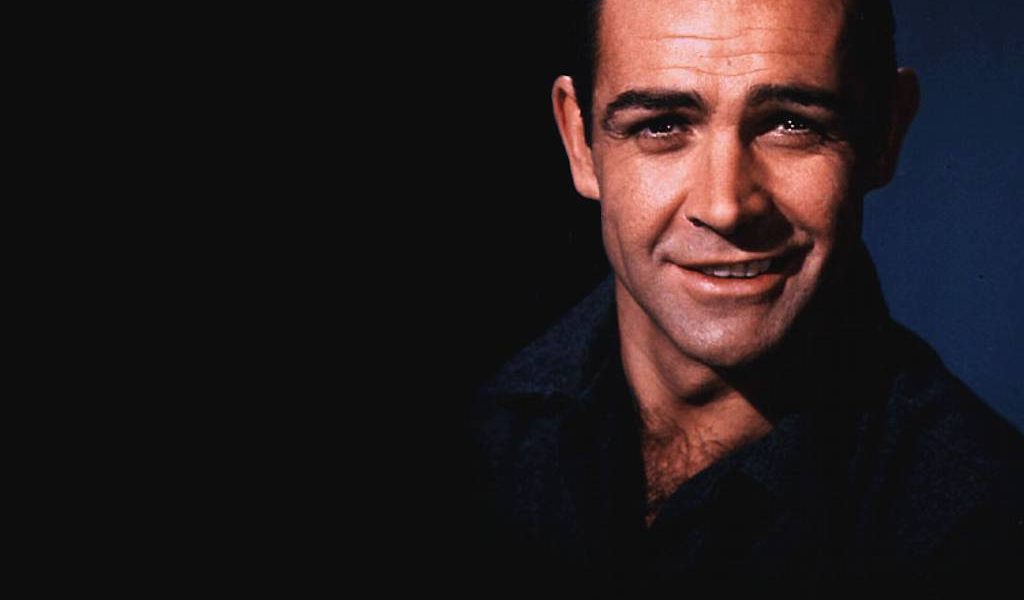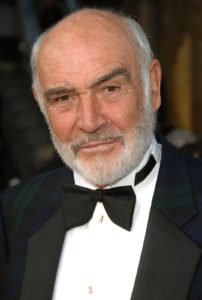 Connery, Sean Connery.
Connery, Sean Connery.
How else to begin a round-up of the famed Irish/Scotsman’s films on this, the month of his birth? Perhaps it’s what’s expected, and for that reason, both completely appropriate and wholly inappropriate – it all depends on which decade of Connery’s career you’re looking at. Hitting the pop culture scene like a sharp shot from his famed Walther PPK, Connery was quickly issued a lifetime license to kill at the box office. Yes, of course the original 007 is still the best. (Even if all the others have value, as well.) But after six Bond films in quick succession, you can’t blame a spy for wanting to come in from the cold. And so, despite his iconic flair as Ian Fleming’s morally-ambivalent secret agent, Connery managed to carve out an intensely varied and distinguished career as both a leading man personality and a working actor in supporting roles. He remained a man of action, but also veered into the occasional prestige project.
So, how about this for an introduction: He’s played both Robin Hood and King Richard. He’s been the Green Knight, King Agamemnon, and King Arthur. (Finally, he was made a real knight!) He’s worked with both Alfred Hitchcock and Brian De Palma, as well as Sidney Lumet numerous times. He’s acted wartime combat and medieval warfare; he’s fled the soviets in one of their own submarines and he’s voiced an honest-to-gosh dragon. He’s the only man to ever escape Alcatraz. He’s Indiana Jones’ father. He’s been on Jeopardy!, a lot. (Nevermind – That wasn’t really him.) He knew how to get Capone, and for that, they gave him an Academy Award.
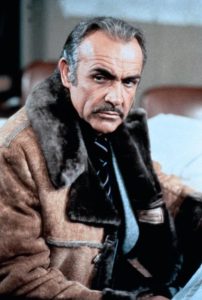
Connery in 1979’s METEOR.
But let’s be honest – he’ll always be James Bond. As a youngster getting turned onto 007 movies, I was quick to learn that some things are not as they appear. No, I’m not referring to the espionage and double dealings in those movies. I’m referring to his first name. For at least a month, reading from the TV Guide and opening titles sequences, I would tell people that my favorite actor was “Seen Connery”. “Sometimes Shawn is spelled S-e-a-n, my dad had to tell me.” Maybe I’ll never be as suave as our man of the month, but getting caught up on his unseen (un-sean?) classics just might help all of us in that department.
For our rundown of notable Connery films heretofore unseen by us, be they good, not so good, or downright perplexing, we’ll begin with a couple Bonds, then work our way through the rest from newest to oldest:
Dr. No
(1962, Eon Productions, Dir. Terence Young)
by Taylor Blake
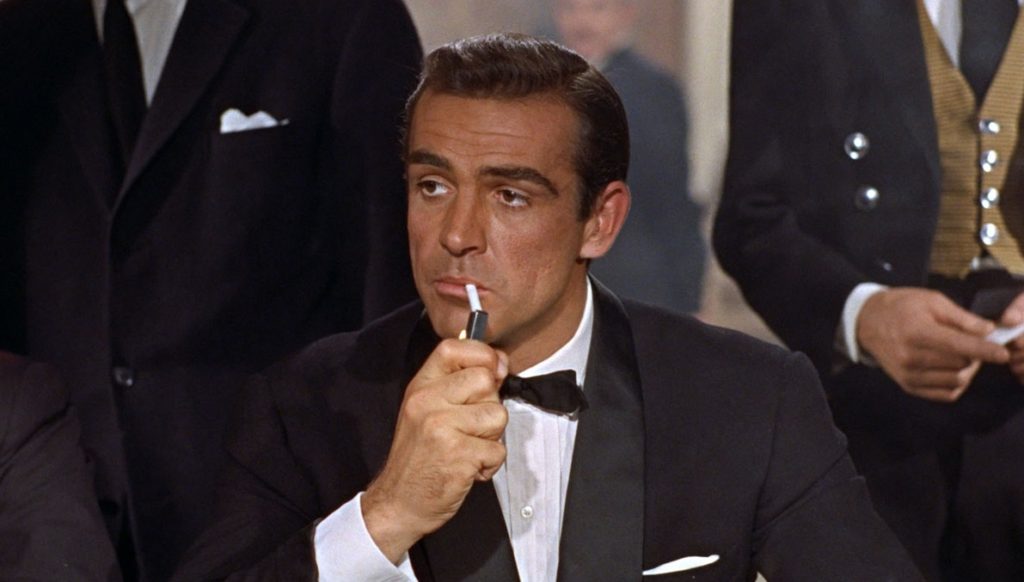
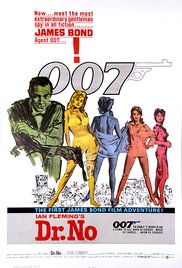 Full disclosure: My limited exposure to James Bond (think 3 of the 4 Daniel Craig episodes) has never left me with a burning desire for more. Espionage flicks require suspended disbelief, and Bond pushes me past my limit. A spy who reminds everyone he meets that he is, in fact, Bond, James Bond doesn’t seem like a solid strategy to me.
Full disclosure: My limited exposure to James Bond (think 3 of the 4 Daniel Craig episodes) has never left me with a burning desire for more. Espionage flicks require suspended disbelief, and Bond pushes me past my limit. A spy who reminds everyone he meets that he is, in fact, Bond, James Bond doesn’t seem like a solid strategy to me.
An introduction to the original Bond, James Bond, in Sean Connery’s Dr. No was a bit of a revelation, partly because it was so similar to the movies of five decades later. Sharp suits, unstirred drinks, swanky opening credits, a penchant for beautiful women who become immediately disposable after sleeping with them—Connery’s Bond has them all. However, Dr. No also introduced a different side to 007: He can be fun. The 21st century Bond interpretation makes him brood in his wounded and tortured past, and while that brings depth, it also forces tons of self-seriousness. No disrespect to Craig, but I prefer watching a performer aware of the ridiculousness around him and still enjoying the ride.
Saying Sean Connery is a charmer hardly begins to grasp him. He’s the magnetic force that pulls this film’s episodic plot together in spite of an ill-defined (and racially insensitive) villain. Even though I’d seen pictures of him as a tuxedoed Bond before, seeing him animated is another experience. He drinks, shoots, and grins with a charisma most screen actors envy. He moves with the camera in mind and even pulls off dodging bullets on a beach looking like a Land’s End model in a blue polo and rolled-up chinos. It also doesn’t hurt that he’s one of the most handsome leading men in the history of cinema. Without him, it’s hard to imagine stars like George Clooney, Brad Pitt, and even Leonardo DiCaprio slipping so easily into their roles as modern leading men who can carry films just with their cults of personality. And with him, he might have achieved what I thought was impossible: I just might want to watch another Bond movie.
Goldfinger
(1964, Eon Productions, Dir. Guy Hamilton)
by Krystal Lyon
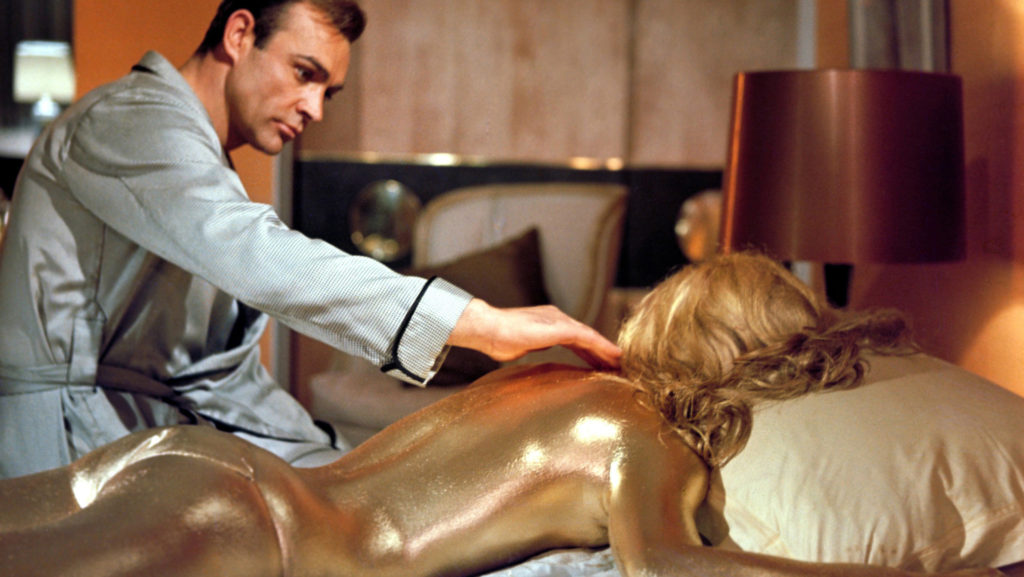
 Oh my word, how is it that I’ve never seen Goldfinger? How have I never experienced Oddjob, the original 007 Aston-Martin tricked out with an ejector-seat, and a woman with the name Pussy Galore? (Really?) I love action, intrigue, over the top style and tongue in cheek references. So I’m just as shocked as you that Goldfinger and ALL Sean Connery 007 films had escaped my viewing. I’ll blame it on my 80’s childhood. I grew up with Roger Moore as 007 in A View To A Kill and Octopussy,(Again, Really??) my two favorites, so Connery’s James Bond was just a bit before my time. In college I fell in laughter-love with Austin Powers in Goldmember. With no knowledge of Goldfinger or any other Connery 007 film I had no clue how close some of the references were. In my twenties I acquired an old Nintendo 64 and played 007: GoldenEye with my friend Sam. There were two rules, you couldn’t be Oddjob and we never played with golden guns. Now, I know where that martini, shaken, not stirred all started. Needless to say, it was an absolute treat to watch the birthday boy this month in Goldfinger. Sean Connery is the source of the modern day spy. Dashing, decked out with impressive gear, and a total ladies man. Connery’s 007 is timeless!
Oh my word, how is it that I’ve never seen Goldfinger? How have I never experienced Oddjob, the original 007 Aston-Martin tricked out with an ejector-seat, and a woman with the name Pussy Galore? (Really?) I love action, intrigue, over the top style and tongue in cheek references. So I’m just as shocked as you that Goldfinger and ALL Sean Connery 007 films had escaped my viewing. I’ll blame it on my 80’s childhood. I grew up with Roger Moore as 007 in A View To A Kill and Octopussy,(Again, Really??) my two favorites, so Connery’s James Bond was just a bit before my time. In college I fell in laughter-love with Austin Powers in Goldmember. With no knowledge of Goldfinger or any other Connery 007 film I had no clue how close some of the references were. In my twenties I acquired an old Nintendo 64 and played 007: GoldenEye with my friend Sam. There were two rules, you couldn’t be Oddjob and we never played with golden guns. Now, I know where that martini, shaken, not stirred all started. Needless to say, it was an absolute treat to watch the birthday boy this month in Goldfinger. Sean Connery is the source of the modern day spy. Dashing, decked out with impressive gear, and a total ladies man. Connery’s 007 is timeless!
So here’s what I loved about Goldfinger, I love the style. Who looks better than Connery in a three-piece suit? Well, Daniel Craig might have him tied. But it’s not just 007 emerging from the sea and unzipping his wetsuit to reveal, you betcha, a tuxedo, no the entire film has that sweet sixties style that is so decadent. From the iconic scene of the girl who died from being coated in gold (Wait, what?) to Pussy Galore and her flying aces in their matching black velvet jumpsuits, Goldfinger oozes opulence. It reminds me of my grandmother’s townhouse in the 80’s, luxurious, over-the-top, a bit gaudy but definitely making a statement.
I love the lines. Connery delivers them effortlessly and with total cool. They are punny, ironic, playful and clever and they work. After knocking a fan into a bathtub to electrocute a nameless hit man, Bond responds with “Shocking! Positively Shocking!” And Auric Goldfinger responds perfectly to 007’s “Do you expect me to talk?” with “No, Mr. Bond, I expect you to die!” But my favorite line might be the ending as 007 saves the day and the girl. As she waves at a search plane for help, he catches her up in his arms and says, “This is no time to be rescued.” I can just imagine people leaving the theater in 1964 quoting these lines, giggling and incorporating them into their conversations over coffee. They are too good and again, timeless.
I loved all of Goldfinger, it’s great entertainment and Sean Connery is the perfect international spy. So now I need to work my way through all the other Connery 007 films and see what other gems I’ve missed. Happy Birthday James, may your Dom Perignon ’53 always be at 38 degrees Fahrenheit and may you never listen to the Beatles without earmuffs.
Highlander
(1986, Thorn EMI Screen Entertainment, Dir: Russell Mulcahy)
by Robert Hornak
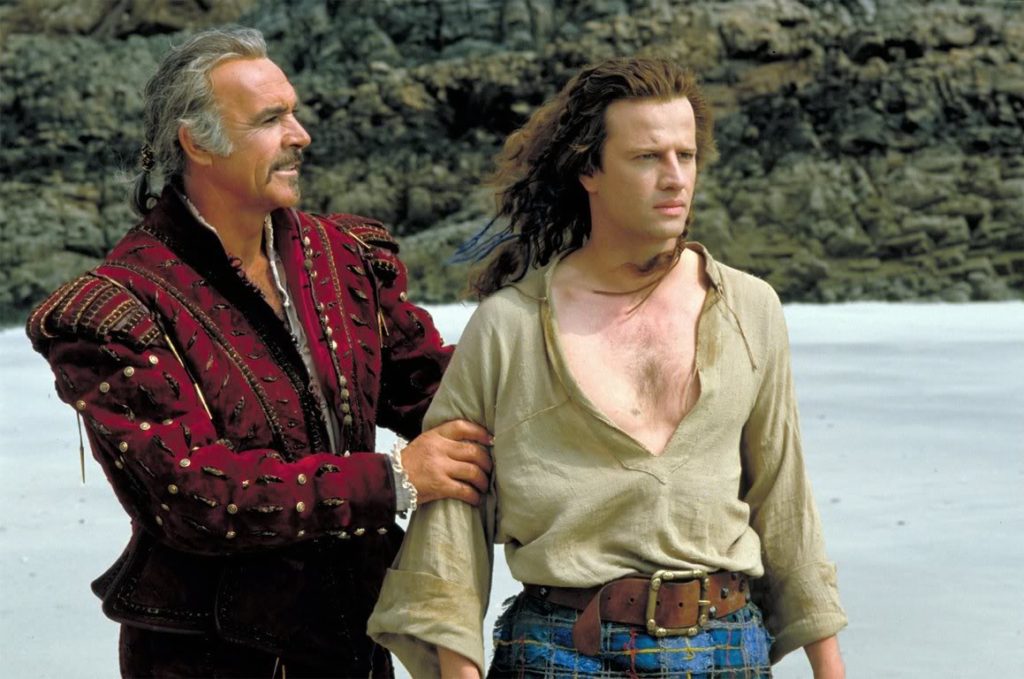
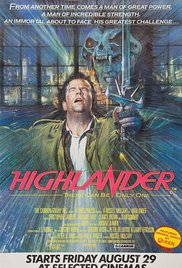 Christopher Lambert plays a never-dying Scottish warrior with the strength of ten men and the forehead of at least three. He’s one of a rare breed of immortals, who’s lived for 500-plus years, along with a few others of his kind scattered across the earth, all hurdling toward a “gathering” that’ll determine which one (“there can be only one!”) will defeat the others and achieve the “quickening” that bestows upon them the greatest power the world has ever known. Now, finally, after epochs of history, across continents, and upon generations of dead and buried, it’s at last settled – on a dark rooftop in New York City in 1986. There’s some great moments of virile daring-do, all covered in blue ’80s electricity, and wall-to-wall sword-fu, but as a story, it feels like it broke into a hundred pieces and got put back together from memory. The time frame flipping back and forth doesn’t help much, taking us from Lambert’s “original” life and haircut to his present one, with a couple of extra eras and a Revolutionary War wig thrown in for color. It’s a sort of Slaughterhouse-5 with kilts – though not actual time travel, it’s all memory/flashbacks that are supposed to generate a head of tense steam toward the final showdown, but doesn’t do much more than push along check-boxing story beats with the end of a rare blade, with some merciful Queen songs to periodically bump it up a notch.
Christopher Lambert plays a never-dying Scottish warrior with the strength of ten men and the forehead of at least three. He’s one of a rare breed of immortals, who’s lived for 500-plus years, along with a few others of his kind scattered across the earth, all hurdling toward a “gathering” that’ll determine which one (“there can be only one!”) will defeat the others and achieve the “quickening” that bestows upon them the greatest power the world has ever known. Now, finally, after epochs of history, across continents, and upon generations of dead and buried, it’s at last settled – on a dark rooftop in New York City in 1986. There’s some great moments of virile daring-do, all covered in blue ’80s electricity, and wall-to-wall sword-fu, but as a story, it feels like it broke into a hundred pieces and got put back together from memory. The time frame flipping back and forth doesn’t help much, taking us from Lambert’s “original” life and haircut to his present one, with a couple of extra eras and a Revolutionary War wig thrown in for color. It’s a sort of Slaughterhouse-5 with kilts – though not actual time travel, it’s all memory/flashbacks that are supposed to generate a head of tense steam toward the final showdown, but doesn’t do much more than push along check-boxing story beats with the end of a rare blade, with some merciful Queen songs to periodically bump it up a notch.
Lambert, like most ’80s action heroes, has a requisite foreign otherness that makes him exotic to the 14-year-old target market. To boot, he’s the tall cowboy who says things like “Love is for poets,” which makes him irresistible to any girl who’d stoop to saying, “You’re not afraid to die, you’re afraid to live.” And he’s got those far-south-of-movie-handsome looks that make him a notch above disposable, like a henchman from another movie that the cameras have spun around to observe for sport. His mentor-sensei-internal monologue, Connery, doesn’t show up for 40 minutes, and only stays for 20, but it’s at least in grand Connery style, with his naturally flowing smug-charm giving the movie a very needed breather. There’s nothing Connery says in that agreeably smiling, neo-Clark Gable scrunch-brow that isn’t fun to listen to, but his arc from intro to head’s-off is so quick it plays like a contractual obligation. His chipper brogue in the opening voiceover made me look forward to his arrival – then his sudden dispatch in mid-act two made me mourn his absence for the next 40 minutes of drippy sword opera. Without Connery, the movie’s a couple drones shy of a bagpipe.
The Name of the Rose
(1986, Neue Constantin Film, Dir: Jean-Jacques Annaud)
by Erik Yates
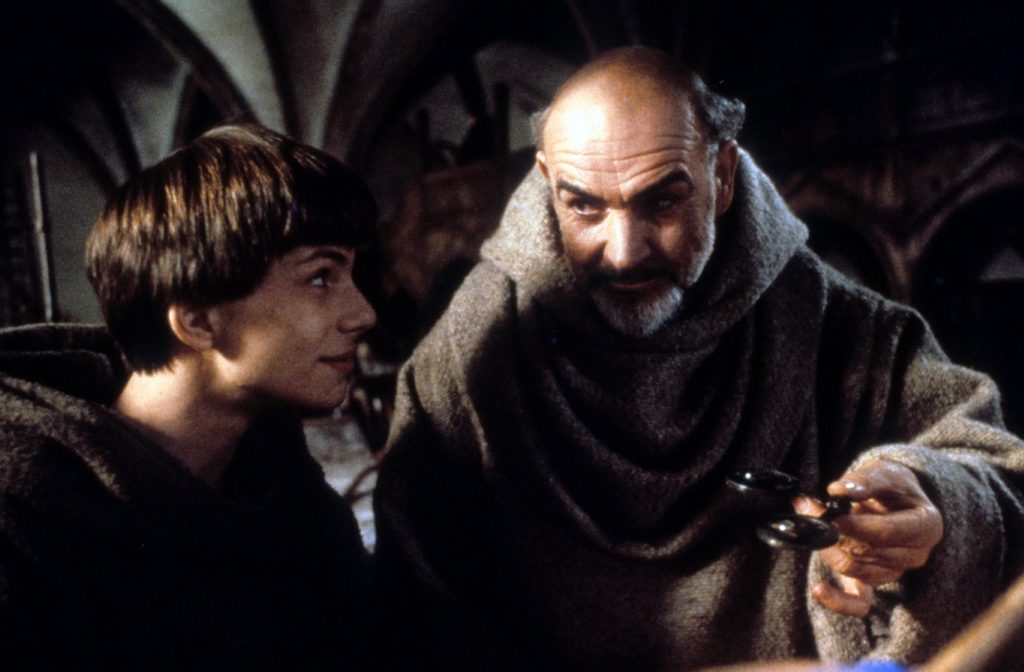
 Jean-Jacques Annaud’s The Name of the Rose was a film that Sir Sean Connery made in the mid-1980’s that was sandwiched in-between Highlander, and The Untouchables. The latter would see Mr. Connery win the best supporting Oscar for his role of Jim Malone, a mentor to Kevin Costner’s Elliot Ness. In The Name of the Rose, Connery is also playing mentor to a young Christian Slater, after serving as a mentor to Connor MacLeod in Highlander. You kind of catch a theme here. The mid to late 1980’s were Connery’s transition into the cool older roles that he would eventually take through his creative revival of the 1990’s in films such as The Hunt for Red October, The Rock, and Entrapment.
Jean-Jacques Annaud’s The Name of the Rose was a film that Sir Sean Connery made in the mid-1980’s that was sandwiched in-between Highlander, and The Untouchables. The latter would see Mr. Connery win the best supporting Oscar for his role of Jim Malone, a mentor to Kevin Costner’s Elliot Ness. In The Name of the Rose, Connery is also playing mentor to a young Christian Slater, after serving as a mentor to Connor MacLeod in Highlander. You kind of catch a theme here. The mid to late 1980’s were Connery’s transition into the cool older roles that he would eventually take through his creative revival of the 1990’s in films such as The Hunt for Red October, The Rock, and Entrapment.
In this film, Connery plays William of Baskerville, an unorthodox Franciscan priest, who along with his protégé Adso of Melk (Slater) are summoned to an abbey in a northern Italian village where several priests have turned up murdered. Connery acts as the Sherlock Holmes of the Catholic Church, using logic to prove what has happened, despite being a place that tends to focus more on faith. His troubled past comes up and interferes with the case with the arrival of the Inquisition, led by F. Murray Abraham’s Bernardo Gui. What is fascinating about any of Connery’s roles, and this one is no different, is how he is able to play so many characters of varied backgrounds with the same Scottish voice, and no one thinks any different. Whether it is playing a Spaniard in Highlander, an Irishman in The Untouchables, or a Russian submarine captain in The Hunt for Red October, Connery essentially just plays himself. His charisma alone often carries the day, making him much like John Wayne who simply was “Irish John Wayne” in his film The Quiet Man. At least with John Wayne, his character of Sean Thornton was coming from America, despite being born in Ireland and raised as an Irish immigrant in an Irish house, and could excuse his lack of an Irish accent. With Connery, it was his star power that attracted people to see these type of films and ignore the fact that Sir Sean Connery was always Scottish, even when he wasn’t. The Name of the Rose is compelling enough of a film to watch today, especially to see a young Ron Pearlman in a very different role. It also may be the film that gave back some of Connery’s swagger that helped him win the Oscar in his next film and propel him back into relevancy with Indiana Jones and the Last Crusade all the way until his unfortunate retirement after 2003’s The League of Extraordinary Gentlemen. No matter what the film is, you can’t help but like Sean Connery, and The Name of the Rose is much the same.
Outland
(1981, Warner Bros., dir. Peter Hyams)
by David Strugar
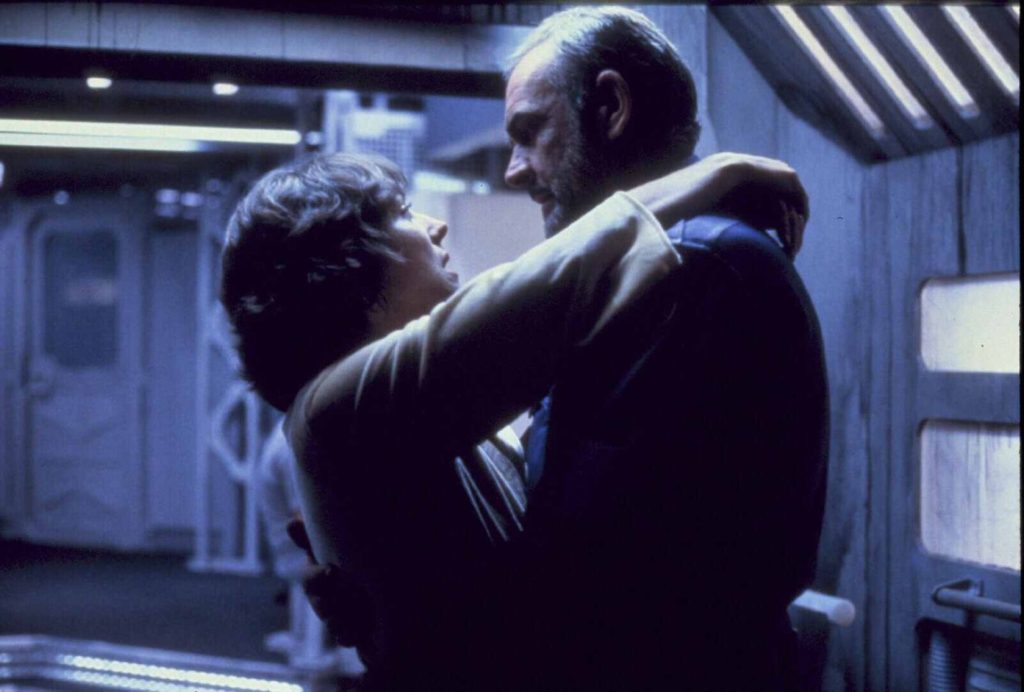
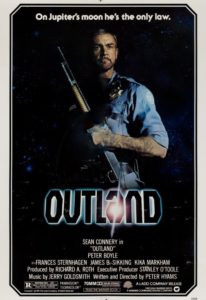 Many a sci-fi director has borrowed Ridley Scott’s visionary cinematic language in the decades since ALIEN, to the point where we’ve just accepted that’s what the near-future looks like now. Peter Hyams’ OUTLAND begins with a title sequence lifted almost verbatim from the previous film (released only two years before). You get the half-formed letters of the title, an eerie score from Jerry Goldsmith, electronic chyrons delivering opening narration, and an industrial tech environment where a distant but powerful mega-corporation manages the lives of its working-class labor force, who all refer to it as “The Company.”
Many a sci-fi director has borrowed Ridley Scott’s visionary cinematic language in the decades since ALIEN, to the point where we’ve just accepted that’s what the near-future looks like now. Peter Hyams’ OUTLAND begins with a title sequence lifted almost verbatim from the previous film (released only two years before). You get the half-formed letters of the title, an eerie score from Jerry Goldsmith, electronic chyrons delivering opening narration, and an industrial tech environment where a distant but powerful mega-corporation manages the lives of its working-class labor force, who all refer to it as “The Company.”
And I dig it.
Hyams speaks Scott’s visual language, but he isn’t trying to make a secret ALIEN spinoff—though one could easily image this story happening in another corner of that world. His similar use of naturalistic dialogue played out over long takes and shot at wide angles plays perfectly for the story he’s trying to tell. Likewise, he captures the sense of isolation, remoteness, and growing paranoia over inexplicable events, building a mystery that presses Sean Connery’s outer space lawman William Marshall into action.
Oh yeah, and speaking of lawmen, the film also borrows from Westerns. Sci-fi has been nodding towards the Western ever since Star Trek and up to and including Firefly, and the re-framing of the High Noon story here is deliberate. Hyams reportedly wanted to make a Western, but then realized the genre was living on in science fiction—again, that isolation and remoteness serve both kinds of stories.
I’m not sure I buy Sean Connery as the weary everyman the script paints him as. Connery’s surely adaptable enough to play, for instance, a bookish old prude who won’t stop calling his son “Junior,” but the beginning of the film needs us to believe he’s sort of a wanderer whose fickle employment situation drives his family away, and that doesn’t click. He has the dogged intelligence and moral inner conflict down pat, though, and once the tension ratchets up, forcing Connery to make a stand against the Company’s corruption, he plays a quiet resolve, tainted with the just right amount of self-doubt.
Also of note: his sidekick, Frances Sternhagen (aka: Cliff Claven’s mom) as the delightfully cranky Dr. Lazarus, has his back and delivers my favorite line—“I’m unpleasant, I’m not stupid.”
Robin and Marian
(1976, Columbia Pictures; dir: Richard Lester)
by Dean Treadway
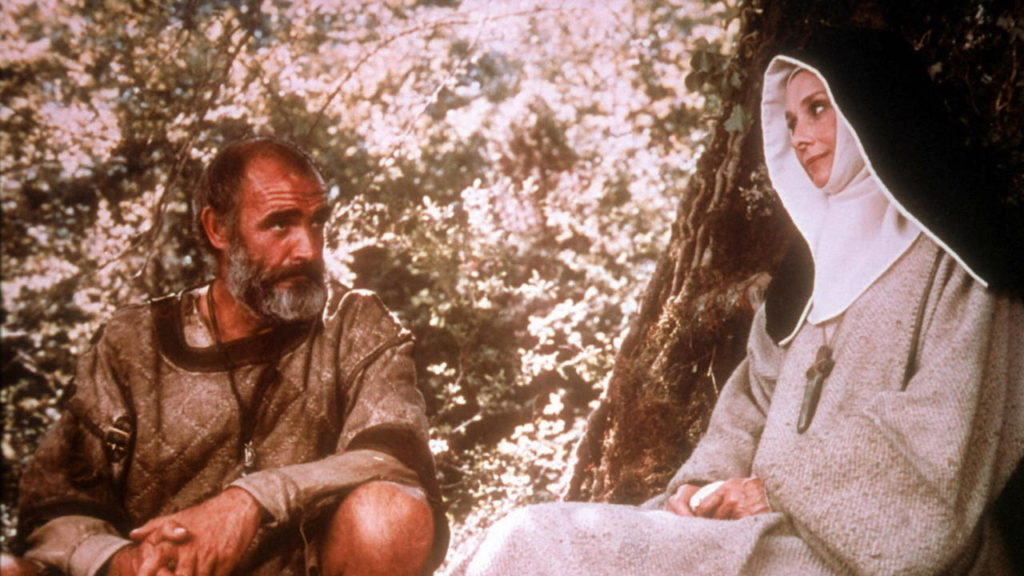
 As usual, it feels like Sean Connery is coasting on his hairy-chested charms as an aged Robin Hood in Richard Lester’s Robin and Marian. This doesn’t mean the film comes unrecommended; its laconic, melancholy air works amidst expected injections of exuberant though creaky-boned action. This gray-bearded Robin Hood has returned to Sherwood Forest after a 20-year stint fighting the Crusades alongside his treasured second, Little John (an excellent Nicol Williamson). Of course, he finds his Maid Marian (Audrey Hepburn, luminous) threatened by the Sheriff of Nottingham (Robert Shaw) and, anyway, one can see where this is going.
As usual, it feels like Sean Connery is coasting on his hairy-chested charms as an aged Robin Hood in Richard Lester’s Robin and Marian. This doesn’t mean the film comes unrecommended; its laconic, melancholy air works amidst expected injections of exuberant though creaky-boned action. This gray-bearded Robin Hood has returned to Sherwood Forest after a 20-year stint fighting the Crusades alongside his treasured second, Little John (an excellent Nicol Williamson). Of course, he finds his Maid Marian (Audrey Hepburn, luminous) threatened by the Sheriff of Nottingham (Robert Shaw) and, anyway, one can see where this is going.
As a Connery vehicle, this film disappoints slightly in that the actor is less front-and-center and more part of an impressive ensemble that includes Denholm Elliott, Richard Harris (blustery as ever), Ian Holm, and British comedian Ronnie Barker as Friar Tuck. Still, he’s game to share the spotlight, and we appreciate that. He doesn’t pick up the trusty bow until midway through the piece, but his participation ramps up as we reach the climax, and it’s easy to adore the sadly romantic scenes he shares with Hepburn, who’s terrific here (though the film could use more of her). She, more than anyone, makes us feel the aching passage of time—it’s heartrending, the scene where she, after shorning her nun habit, inspects Robin’s many battle scars and reminisces “You had the sweetest body when you left—hard and not a mark. And you were mine.” Connery does have one lively moment, in a later cuddle with Hepburn, where he endeavors to convince her he’s every bit the man he once was.
Screenwriter James Goldman comes up with intriguing dialogue, however long a way we are from his yeoman work on The Lion in Winter (particularly effective is the gentle introduction of Little John’s unrequited crush on Marian). But I wish the picture had beefed up the parts for the other Merry Men, and that it had been more brave in focusing in on the romance between Robin and Marian (given the film’s title), but I suppose you can’t have a Robin Hood film without horse hooves and archery.
Also, it’s easy to miss the more adventurous filmmaking of Richard Lester’s fast-cutting ’60s heyday. Certainly, among the film’s chief attributes is its score, by frequent Lester collaborator John Barry, who reliably nails the lush action and romantic beats. Visually, its design reminds one of the low-budget but authentic feel of Monty Python and the Holy Grail, but its look could‘ve been improved by filming in Britain, or anywhere else in Europe, instead of Spain; this is an unusually sandy, sun-baked Sherwood Forest, and one is left hungering for more overcast greenery from photographer David Watkin. Still, Robin and Marian stands as a reasonably diverting watch.
Zardoz
(1974, John Boorman Productions, Dir: John Boorman)
by Sharon Autenrieth
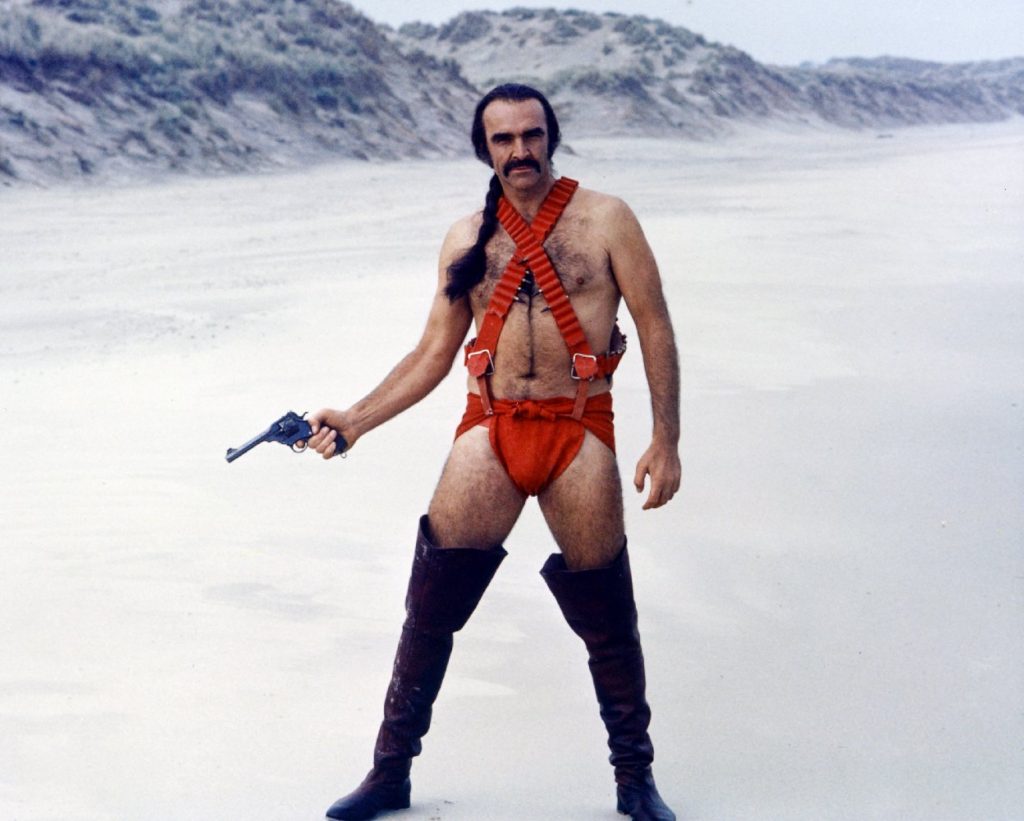
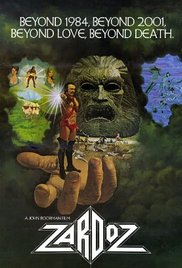 Late in Zardoz, John Boorman’s post-apocalyptic drug trip, Zed (Sean Connery) says, “I see nothing inside except my own perplexity.” I understand Zed, I do. Zardoz is the kind of movie that will produce an existential crisis like that. Zardoz is famously bad, but I wasn’t prepared for just how bizarre it is – or for the movie’s extended attention given to penises.
Late in Zardoz, John Boorman’s post-apocalyptic drug trip, Zed (Sean Connery) says, “I see nothing inside except my own perplexity.” I understand Zed, I do. Zardoz is the kind of movie that will produce an existential crisis like that. Zardoz is famously bad, but I wasn’t prepared for just how bizarre it is – or for the movie’s extended attention given to penises.
It’s 2293 and humanity is divided into two camps – educated, privileged, vapid “eternals” and savage “brutals”. Zed is a brutal, but also an exterminator, serving his god Zardoz by mowing down other brutals or forcing them into slavery. Zardoz is a giant floating head (Terry Gilliam must have appreciated this bit, at least) and Zed “finds” himself riding inside the head into one of the vortex’s in which the eternals live….and live…and live…and live…because they’re literally eternal, but as is so often the case with such things, humanity’s best and brightest have gotten bored and spend a lot of time bickering and longing for sweet, sweet death.
As Zed, Sean Connery spends almost the entire movie in thigh high boots, a red loincloth, and matching red bandoliers. He also wears a long, braided hair piece and one of two expressions: confused or smug. Actually, .Zed doesn’t look confused very often -I’m confusing him with me, watching this film. Mostly Zed looks smug, as when he’s being told by the hot eternal sisters Consuella (Charlotte Rampling) and May (Sara Kestelman) how special his genetics are, or when he manages to produce an erection in front of a crowd without even needing porn. Zed is pretty special, alright, and humanity needs him to save us from ourselves, and also from hairstyles and clothing choices that are even worse than his.
Actually, Zed does have a third expression: rage, after reading “The Wizard of Oz”. I won’t spoil the movie’s very complicated reveal by telling you why “The Wizard of Oz” matters: I will only say that Zardoz might be taken as a thoughtful critique of religion, if it wasn’t so ridiculous in every possible way.
Zardoz is certainly bad enough to be enjoyed as a bad movie, and Sean Connery is at his hairy, beefy, “Aren’t I a sexy beast?” best/worst in this role. But it’s not fun for the whole family, as many of the female characters flutter through the film topless. The eternals have stopped procreating, but you can tell just by looking at them that the problem is more on one side of the gender divide than the other. The male eternals are fey, delicate, sardonic. They’re basically Oscar Wilde with worse taste. The women, on the other hand, clearly have an itch that only Zed can scratch. He’s got such powerful animal magnetism that a tiny taste of his sweat is enough to bring catatonics back to life (no, really).
If all of that sounds intriguing and you’re not put off by the topless women and the 101 level lecture (complete with slides) on the male erection…then Zardoz is for you!
Darby O’Gill and the Little People
(1959, Walt Disney Productions, Dir: Robert Stevenson)
by Jim Tudor
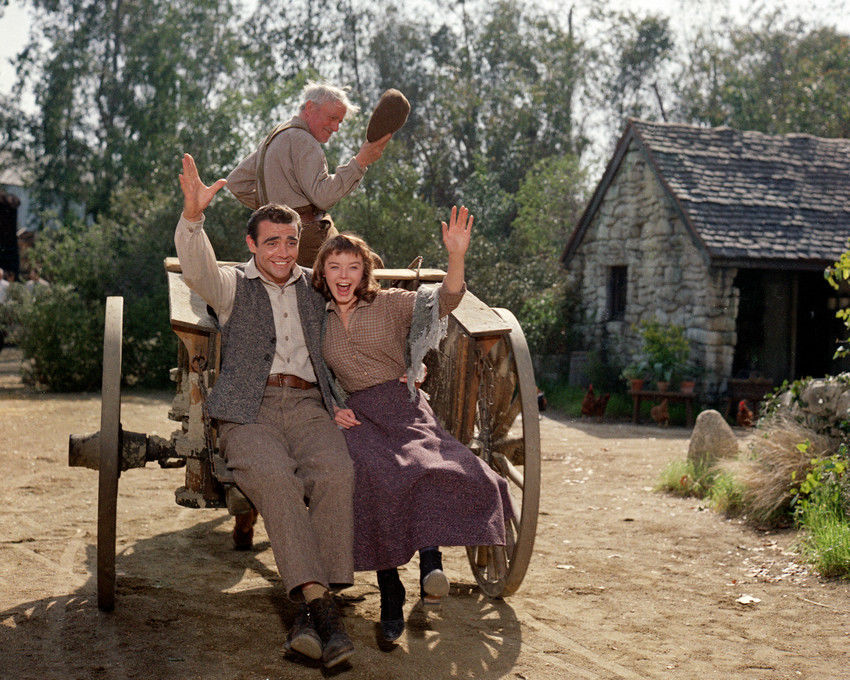
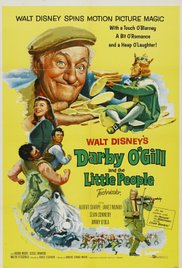 Darby O’Gill and the Little People has been hiding in plain sight. Even after acquiring a copy of the DVD for fifty cents at a rummage sale, I still didn’t bother to watch it. Until now, of course. Why the avoidance? Several likely reasons. Foremost, after so many years of Conan O’Brien jokes about the movie, I was expecting something a lot more hokey and garish. I had it in my head that this film was made later than it was, circa the late 1960s, which would typically mean that for a Disney effort, it’d be more likely lacking. But no – it turns out that Darby O’Gill hails from 1959, with Disney live action ace director Robert Stevenson at the top of his game, and boasting wall to wall astonishing visual effects.
Darby O’Gill and the Little People has been hiding in plain sight. Even after acquiring a copy of the DVD for fifty cents at a rummage sale, I still didn’t bother to watch it. Until now, of course. Why the avoidance? Several likely reasons. Foremost, after so many years of Conan O’Brien jokes about the movie, I was expecting something a lot more hokey and garish. I had it in my head that this film was made later than it was, circa the late 1960s, which would typically mean that for a Disney effort, it’d be more likely lacking. But no – it turns out that Darby O’Gill hails from 1959, with Disney live action ace director Robert Stevenson at the top of his game, and boasting wall to wall astonishing visual effects.
Perhaps I avoided it for not wanting to hear Sean Connery sing, something I’ve heard tell of in conjunction with this movie. Honestly though, he’s not bad! Perhaps his breakout singing performance here paved the way for his carrying a few lines of “Under the Mango Tree” in Dr. No. His song, “Pretty Irish Girl”, sung along with the cute-as-a-button Janet Munro, was released as a single! (Although rumors persist that both actors were dubbed by proper singers. They sell it, at any rate). Connery is perfectly fine in his handsome dashing lad role, with one fistfight scene telegraphing the man of action he will become. But he is not the male lead in the film. That honor goes to the aged (at the time, retired) stage actor Albert Sharpe. Sharpe is Darby O’Gill, a poor Irish villager who manages to capture a wish- granting leprechaun king, played by Jimmy O’Dea. Together, they provide some of the film’s best banter. Which is all the more impressive considering that due to the forced perspective effects necessary to make O’Dea appear one-forth his true size, the actors were actually 25 feet away from one another, faking eyelines!
Darby O’Gill and the Little People is a solid dose of Disney-fied Irish folklore (the wailing banshee transfixed my kids, for sure!) that is less Lucky Charms and more charming, old world myth. Having seen the film, I can report that it is nothing to be ashamed of. Whether you’re settling in with a pint or settling in the family, Stevenson’s trip to the Emerald Isle is something special.


